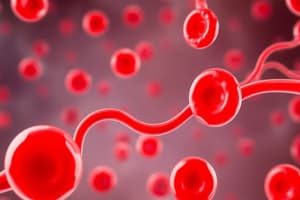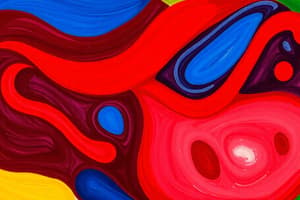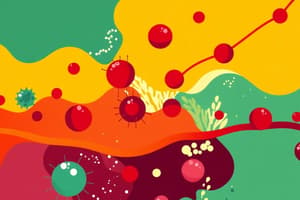Podcast
Questions and Answers
What process activates complement in the given context?
What process activates complement in the given context?
- Cleavage of C3 (correct)
- Protein synthesis
- Mitosis
- Phagocytosis
C3a acts as a potent anaphylotoxin causing increased vascular permeability.
C3a acts as a potent anaphylotoxin causing increased vascular permeability.
True (A)
What function does C3b serve in the immune response?
What function does C3b serve in the immune response?
Opsonization
Human High Molecular Weight Kininogen (HMWK) has a molecular weight of ______ daltons.
Human High Molecular Weight Kininogen (HMWK) has a molecular weight of ______ daltons.
Which serine protease is NOT mentioned as being implicated in clinical disorders?
Which serine protease is NOT mentioned as being implicated in clinical disorders?
Antithrombin is a serine protease inhibitor involved in thrombin inhibition.
Antithrombin is a serine protease inhibitor involved in thrombin inhibition.
During reperfusion, complement may be activated by exposure to ______ components.
During reperfusion, complement may be activated by exposure to ______ components.
Match the complement components to their functions:
Match the complement components to their functions:
Which of the following components is NOT part of the complement system?
Which of the following components is NOT part of the complement system?
Activated complement fragments can damage self-tissues.
Activated complement fragments can damage self-tissues.
What is the primary role of activated complement fragments?
What is the primary role of activated complement fragments?
Cells express regulators of complement activation to protect against __________.
Cells express regulators of complement activation to protect against __________.
What is the normal range for activated partial thromboplastin time (APTT)?
What is the normal range for activated partial thromboplastin time (APTT)?
Anticoagulants are expected to increase the inflammatory response.
Anticoagulants are expected to increase the inflammatory response.
Name one of the major natural anticoagulant mechanisms.
Name one of the major natural anticoagulant mechanisms.
The __________ is the test of choice for screening deficiencies of factors I, II, V, VII, and X.
The __________ is the test of choice for screening deficiencies of factors I, II, V, VII, and X.
Match the following proteins with their roles in the coagulation and complement systems:
Match the following proteins with their roles in the coagulation and complement systems:
What can cause prolonged APTT?
What can cause prolonged APTT?
Which of the following statements about coagulation factors is true?
Which of the following statements about coagulation factors is true?
Factors VIII and XI are referred to by their common names.
Factors VIII and XI are referred to by their common names.
What is the common name for factor IX, which is often associated with hemophilia?
What is the common name for factor IX, which is often associated with hemophilia?
The primary substrate in the coagulation cascade is __________.
The primary substrate in the coagulation cascade is __________.
Match the coagulation factors to their corresponding roles:
Match the coagulation factors to their corresponding roles:
What is the primary function of CD59 in the complement system?
What is the primary function of CD59 in the complement system?
Antithrombin-III provides significant anti-inflammatory properties.
Antithrombin-III provides significant anti-inflammatory properties.
Name two serine protease inhibitors mentioned in the content.
Name two serine protease inhibitors mentioned in the content.
The activation of the complement system involves the assembly of the __________.
The activation of the complement system involves the assembly of the __________.
What percentage of the antithrombin activity in normal plasma is derived from AT-III?
What percentage of the antithrombin activity in normal plasma is derived from AT-III?
Activated Partial Thromboplastin Time (aPTT) is related to the observation that hemophiliacs have prolonged clotting time.
Activated Partial Thromboplastin Time (aPTT) is related to the observation that hemophiliacs have prolonged clotting time.
Which anticoagulant is effective against factors XIIa and XIa?
Which anticoagulant is effective against factors XIIa and XIa?
In severe cases like septic shock, antithrombin-III is proven to be __________.
In severe cases like septic shock, antithrombin-III is proven to be __________.
Match the following components with their functions:
Match the following components with their functions:
What type of molecules do complete thromboplastins consist of?
What type of molecules do complete thromboplastins consist of?
Which of the following factors is NOT a cofactor in the coagulation cascade?
Which of the following factors is NOT a cofactor in the coagulation cascade?
All enzymes involved in the coagulation cascade are classified as serine proteases.
All enzymes involved in the coagulation cascade are classified as serine proteases.
What is the role of tissue factor in the coagulation cascade?
What is the role of tissue factor in the coagulation cascade?
The physiological process that removes insoluble fibrin clots is called ______.
The physiological process that removes insoluble fibrin clots is called ______.
Match the following factors with their corresponding group in the coagulation cascade:
Match the following factors with their corresponding group in the coagulation cascade:
Which enzyme digests fibrin to assist in fibrinolysis?
Which enzyme digests fibrin to assist in fibrinolysis?
Fibrin polymerization is part of the coagulation process.
Fibrin polymerization is part of the coagulation process.
What is the primary function of fibrinogen in hemostasis?
What is the primary function of fibrinogen in hemostasis?
The ______ cascade is initiated by tissue factor binding to factor VII.
The ______ cascade is initiated by tissue factor binding to factor VII.
Which factor is involved in the regulation of fibrinolytic function through the renin-angiotensin-aldosterone system?
Which factor is involved in the regulation of fibrinolytic function through the renin-angiotensin-aldosterone system?
Flashcards are hidden until you start studying
Study Notes
Coagulation Cascade
- Coagulation factors are designated by Roman numerals
- Activation of a factor is indicated by the lowercase "a" next to the Roman numeral
- Coagulation factors may be categorized as substrates, cofactors, and enzymes
- Fibrinogen is the main substrate
- Examples of cofactors include tissue factor, factor V, factor VIII, and Fitzgerald factor
- All coagulation factors, except factor XIII, are serine proteases when activated
- Coagulation factors may be categorized into three groups: contact proteins, prothrombin proteins, and fibrinogen or thrombin-sensitive proteins
- Contact proteins include factors XII, XI, prekallikrein (PK), and high-molecular-weight kininogen (HMWK).
- Prothrombin proteins include factors II, VII, IX, and X.
- Fibrinogen or thrombin-sensitive proteins include factors I, V, VIII, and XIII.
High-Molecular-Weight Kininogen (HMWK)
- HMWK is a single-chain protein with a molecular weight of 120,000 daltons
- Cleaved by human urinary kallikrein (HUK) to release kinin
- Forms a 2-chain protein that retains procoagulant activity
- Serves as a cofactor for FXI and PK assembly on biologic membranes
- Docking of HMWK to platelet and EC membranes requires binding to both its heavy and light chains
Serine Proteases & Inhibitors
- Serine proteases (thrombin, FXa, elastase, trypsin) are implicated in inflammatory disorders like emphysema, arthritis, and cardiovascular diseases
- Naturally occurring serine protease inhibitors (antithrombin) regulate these enzymes
- Antithrombin is the first plasma coagulation regulatory protein identified and assayed
- It inactivates thrombin, FXa, and the TF/FVIIa complex
- Antithrombin inhibits numerous enzymes, including factors XIIa, XIa, IXa, protein S, protein C, plasmin, and kallikrein
Complement System
- The complement system consists of approximately 22 serum proteins
- Activated complement fragments can damage self-tissues
- Cells express regulators of complement activation to protect themselves
- Abnormalities in these regulators may contribute to autoimmune and inflammatory disorders
Activated Partial Thromboplastin Time (APTT)
- Developed from the observation that hemophiliacs have prolonged clotting time
- APTT reflects the activity of PK, HMWK, and factors XII, XI, VIII, X, V, II, and I
- APTT may be prolonged due to a factor deficiency or the presence of circulating anticoagulants
- Normal APTT is less than 35 seconds
Prothrombin Time (PT)
- Screens for deficiencies in factors I, II, V, VII, and X
- PT is the test of choice for these deficiencies
Fibrinolytic System
- Fibrinolysis is the process that removes insoluble fibrin clots
- Catalyzed by the enzymatic digestion of cross-linked fibrin polymers
- Plasmin is a key enzyme in fibrinolysis, digesting fibrin and fibrinogen to produce smaller fragments
- Angiotensin II may regulate fibrinolytic function
Antithrombin (AT-III)
- More than 90% of the antithrombin activity in normal plasma is from AT-III
- Exerts anti-inflammatory properties
- Effective in experimental models of sepsis, septic shock, and disseminated intravascular coagulation (DIC)
Platelet Plug Formation
- Platelet plug formation is a part of primary hemostasis
- Platelets adhere to exposed collagen, leading to platelet activation and degranulation
- Released mediators include ADP, TXA2, serotonin, and β-thromboglobulin
- Platelet aggregation (ATP, fibrinogen, GPIIb, GPIIIa) reinforces the platelet plug
Hemostasis
- Hemostasis is the process that stops bleeding
- Involves vascular spasm, platelet plug formation, and coagulation cascade activation
- Coagulation factors and platelets work together to form a stable clot
Studying That Suits You
Use AI to generate personalized quizzes and flashcards to suit your learning preferences.




